The creator economy’s impact on traditional media buying and planning is reshaping how brands connect with audiences. As creators wield increasing influence, marketers must rethink conventional strategies. Explore how creator-driven dynamics are transforming ad spends, planning approaches, and campaign effectiveness—and what your business needs to thrive in this new landscape.
The Emergence of the Creator Economy in Media Buying
In 2025, the creator economy is a fundamental force in media. Social media personalities, independent content creators, and digital-first influencers now command audiences rivaling traditional broadcasters. According to Insider Intelligence, creator marketing spend will surpass $33 billion globally this year. This shift compels media planners to allocate budgets beyond TV, radio, and print, integrating creator partnerships as a primary consideration. Brands can no longer afford to overlook creators’ storytelling capacity and their authentic relationship with niche audiences. The creator economy is not just an alternative—the model is quickly becoming the bedrock of modern media buying strategy.
Changing Consumer Behaviors: Audiences Favoring Creator Content
Consumer media habits have dramatically shifted. A 2025 GWI study reveals over 65% of Gen Z and Millennials now trust creator content as much as, or more than, traditional advertisements. People crave authenticity and relatability, finding it in the personal brands they follow. This means traditional media plans that lean heavily on opaque mass media placements may miss the mark. Success hinges on harnessing creators who can build genuine rapport, engage two-way conversations, and foster brand loyalty. The demand for relevance and trust is putting creators—and, by extension, brands working with them—at the forefront of the evolving attention economy.
Ad Spend Diversification: How Marketers Are Allocating Budgets
Facing fragmented audiences and declining effectiveness of standard ads, marketers in 2025 are diversifying their media mix. WARC’s latest global survey finds that almost 40% of large brands now designate at least a quarter of their advertising budget to creator partnerships. This budget realignment reflects clear ROI: creator content delivers higher engagement and measurable conversions than several conventional ad formats. Marketers are also experimenting with longer-term creator collaborations, subscription models, and sponsored educational content, reinforcing the point that creator-based media buying demands flexibility and trust-driven partnerships, rather than one-off transactions.
Evolution in Media Planning: Integrating Creators into Omnichannel Strategies
Media planning is no longer about selecting platforms and negotiating rates. Today’s planners must orchestrate creator partnerships across multiple touchpoints—social feeds, live streams, newsletters, podcasts, and more. Tools powered by AI and performance analytics are speeding up the selection and vetting of ideal creators for specific campaigns. Planners now track impact metrics like engagement share, sentiment analysis, and conversion attribution directly linked to creator activities. By coordinating creator content alongside traditional ads and owned channels, brands achieve consistent messaging and maximize their audience reach. The brands adapting quickest to this model are setting new benchmarks for both media efficiency and cultural relevance.
Measurement and Accountability in Creator Campaigns
Historically, brands struggled to measure the real impact of influencer and creator marketing. In 2025, this has changed, thanks to advanced tools for attribution modeling, first-party data collection, and real-time analytics dashboards. These platforms now quantify KPIs such as click-through rates, sales lift, customer retention, and even brand sentiment shifts. Major media agencies use these metrics to prove the business value of creator campaigns, securing higher budgets and winning more c-suite buy-in. Despite lingering challenges—such as creator fraud and privacy constraints—innovations in transparent contracts and blockchain-powered verification are elevating industry standards for accountability and trust.
Risks and Best Practices: Navigating the Creator Economy
Working with creators offers immense upside, but brands face unique risks. Issues like brand safety, creative control, contractual ambiguities, and authenticity lapses remain. To mitigate these risks, industry leaders in 2025 recommend:
- Thorough vetting: Use AI-powered background checks and audience analysis before engagement.
- Clear guidelines: Agree on deliverables, messaging, and content review rights upfront.
- Long-term relationships: Foster genuine collaboration rather than transactional, one-off campaigns.
- Focus on measurement: Establish upfront KPIs with transparent reporting mechanisms.
- Prioritize brand fit: Align with creators who share your company values and understand your target audience.
By adopting these best practices, brands can maximize creator campaign impact, reduce risk, and build enduring trust with consumers.
Conclusion: Adapting to a Creator-Driven Media Landscape
Traditional media buying and planning are being reinvented by the creator economy. Brands that embrace flexible strategies, prioritize genuine creator partnerships, and invest in accountable measurement will outperform competitors. As consumer trust shifts to creators, forward-thinking marketers and planners must adapt fast—or risk becoming obsolete in the evolving media landscape.
FAQs: The Creator Economy’s Impact on Media Buying and Planning
- How is the creator economy changing traditional media buying?
Creators offer authentic, targeted communication, shifting ad budgets from mass media to niche, influencer-led content. This creates more personalized reach and measurable engagement. - What should media planners do differently in 2025?
Planners must integrate creators into media strategies, leverage new performance analytics, and coordinate messaging across both digital and traditional channels for coherent campaigns. - How can brands measure the effectiveness of creator campaigns?
Use modern analytics tools to track KPIs like engagement, sales attribution, sentiment, and ROI. Set clear, measurable goals at campaign inception to enhance transparency. - What are the main risks in creator partnerships, and how are they managed?
Risks include brand misalignment and loss of creative control. Mitigate these with robust vetting, clear contracts, detailed guidelines, and ongoing relationship management. - Why do consumers trust creators more than traditional media?
Creators provide relatable, niche content and direct interaction with audiences, building trust via perceived authenticity compared to impersonal mass advertising.
